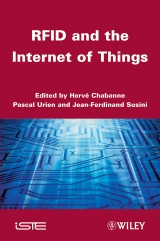Details

RFID and the Internet of Things
1. Aufl.
|
139,99 € |
|
| Verlag: | Wiley |
| Format: | |
| Veröffentl.: | 04.03.2013 |
| ISBN/EAN: | 9781118614433 |
| Sprache: | englisch |
| Anzahl Seiten: | 304 |
DRM-geschütztes eBook, Sie benötigen z.B. Adobe Digital Editions und eine Adobe ID zum Lesen.
Beschreibungen
RFID (Radio Frequency Identification) technology allows for automatic identification of information contained in a tag by scanning and interrogation using radio frequency (RF) waves.<br /> An RFID tag contains an antenna and a microchip that allows it to transmit and receive. This technology is a possible alternative to the use of barcodes, which are frequently inadequate in the face of rapid growth in the scale and complexity of just-in-time inventory requirements, regional and international trade, and emerging new methods of trade based on it. Use of RFID tags will likely eventually become as widespread as barcodes today.<br /> This book describes the technologies used for implementation of RFID: from hardware, communication protocols, cryptography, to applications (including electronic product codes, or EPC) and middleware.<br /> The five parts of this book will provide the reader with a detailed description of all the elements that make up a RFID system today, including hot topics such as the privacy concerns, and the Internet of Things.
<p><b>Foreword xi</b><br /> Guy Pujolle</p> <p><b>Part One: Physics of RFID 1</b></p> <p><b>Chapter 1. Introduction 3</b><br /> Simon Elrharbi, Stefan Barbu</p> <p>1.1. Bibliography 5</p> <p><b>Chapter 2. Characteristics of RFID Radio Signals 7</b><br /> Simon Elrharbi, Stefan Barbu</p> <p>2.1. Description and operating principle of RFID systems 7</p> <p>2.2. Transmission channel 19</p> <p>2.3. First level electric model in inductive coupling 31</p> <p>2.4. Bibliography 55</p> <p><b>Chapter 3. RFID Communication Modes 57</b><br /> Simon Elrharbi, Stefan Barbu</p> <p>3.1. Communication modes 57</p> <p>3.2. Bibliography 68</p> <p><b>Part Two: RFID Applications 69</b></p> <p><b>Chapter 4. Applications 71</b><br /> François Lecocq, Cyrille Pépin</p> <p>4.1. Introduction 71</p> <p>4.2. History: evolution from barcodes to RFID tags 72</p> <p>4.3. RFID tags 83</p> <p>4.4. Normalization/standardization 89</p> <p>4.5. Advantages/disadvantages of RFID tags 98</p> <p>4.6. Description of RFID applications 102</p> <p>4.7. Application examples 103</p> <p>4.8. Conclusion 109</p> <p>4.9. Bibliography 111</p> <p><b>Part Three: Cryptography of RFID 113</b></p> <p><b>Chapter 5. Cryptography and RFID 115</b><br /> Julien Bringer, Hervé Chabanne, Thomas Icart, Thanh-Ha Le</p> <p>5.1. Introduction 115</p> <p>5.2. Identification protocols and security models 116</p> <p>5.3. Identification protocols 121</p> <p>5.4. Conclusion. Physical attacks on RFID devices 141</p> <p>5.5. Bibliography 144</p> <p><b>Part Four: EPCglobal 151</b></p> <p><b>Chapter 6. EPCglobal Network 153</b><br /> Dorice Nyamy, Mathieu Bouet, Daniel de Oliveira Cunha, Vincent Guyot</p> <p>6.1. Introduction 153</p> <p>6.2. Tags 154</p> <p>6.3. EPCglobal architecture 164</p> <p>6.4. Conclusion 179</p> <p>6.5. Bibliography 180</p> <p><b>Part Five: Middleware 183</b></p> <p><b>Chapter 7. Middleware for the Internet of Things: Principles 185</b><br /> David Durand, Yann Iagolnitzer, Patrice Krzanik, Christophe Loge, Jean-Ferdinand Susini</p> <p>7.1. Distributed applications 187</p> <p>7.2. RPC: Remote Procedure Call 188</p> <p>7.3. Object-oriented middlewares 189</p> <p>7.4. Summary of object-oriented middleware architectures 195</p> <p>7.5. The XML revolution 199</p> <p>7.6. Middleware for the Internet of Things 208</p> <p>7.7. Conclusion 213</p> <p>7.8. Bibliography 213</p> <p><b>Chapter 8. Middleware for the Internet of Things: Standards 217</b><br /> Yann Iagolnitzer, Patrice Krzanik, Jean-Ferdinand Susini</p> <p>8.1. EPCglobal application environment 218</p> <p>8.2. General introduction to message-oriented middleware 219</p> <p>8.3. Service-oriented middleware 231</p> <p>8.4. Conclusion 242</p> <p>8.5. Bibliography 242</p> <p><b>Chapter 9. Middleware for the Internet of Things: Some Solutions 245</b><br /> Yann Iagolnitzer, Patrice Krzanik, Jean-Ferdinand Susini</p> <p>9.1. EPCglobal and SUN Java RFID software 246</p> <p>9.2. .NET and RFID services platform 250</p> <p>9.3. IBM Websphere RFID Suite 256</p> <p>9.4. Singularity 258</p> <p>9.5. Middleware for embedded systems 260</p> <p>9.6. ObjectWeb projects and the Internet of Things 265</p> <p>9.7. Conclusion 276</p> <p>9.8. Bibliography 276</p> <p><b>List of Authors 279</b></p> <p><b>Index 283</b></p>
<p><strong>Hervé Chabanne</strong> is a deputy director, R&T, and security expert at Morpho, an expert for the Safran group, and an associate professor at Télécom ParisTech in France. He is also a senior member of the IEEE. <p><strong>Pascal Urien</strong> is a professor at Télécom ParisTech in France. <p><strong>Jean-Ferdinand Susini</strong> is an assistant professor at the Conservatoire National des Arts et Metiers in Paris, France.


















